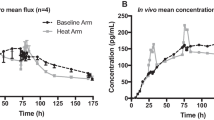Abstract
Relationships between the in vitro permeation rates of select narcotic analgesics through human skin and their physicochemical properties were investigated by following the permeation kinetics of six representative compounds in small diffusion cells. The relative permeability coefficients of three phenylpiperidine analogues, meperidine, fentanyl, and sufentanil, all measured on a single piece of skin, were 3.7 × 10−3, 5.6 × 10−3, and 1.2 × 10−2 cm/hr, respectively. Using membranes from the same skin section, the permeability coefficients of three opioid alkaloids, morphine, codeine, and hydromorphone, were considerably lower, at 9.3 × 10−6, 4.9 × 10−5, and 1.4 × 10−5 cm/hr, respectively. The high permeability coefficients of the former compounds are due to their highly lipophilic nature as reflected in high octanol/water partition coefficients and low solubility parameters. Generally, the permeability coefficients of the narcotics increase as the lipophilicity increases. When viewed in literature perspective, the data suggest that aqueous tissue control of transport is approached in the case of the phenylpiperidine analogues, all of which have K octanol/water values greater than 40. Permeability coefficients of fentanyl and sufentanil were also determined as a function of pH over the pH range 7.4 to 9.4, in this instance with membranes prepared from additional samples of skin. The permeability coefficients of each drug varied less than threefold over the pH range, a behavior consistent with the highly hydrophobic natures of the compounds. The low permeability coefficients of morphine, codeine, and hydromorphone coupled with their low potencies make these drugs poor transdermal candidates. It appears that fentanyl and sufentanil can be successfully transdermally delivered.
Similar content being viewed by others
REFERENCES
R. D. Adams. In M. Weisenberg (ed.), Pain-Clinical and Experimental Perspective, C. V. Mosby, St. Louis, Mo., 1975, pp. 326–331.
M. J. Chatton. In M. A. Krupp and M. J. Chatton (eds.), Current Medical Diagnosis and Treatment, Lang, Los Altos, Calif., 1982, p. 9.
R. B. Catalano. Semin Oncol. 2:379–392 (1975).
A. G. Lipman. Cancer Nurs. 3:39–46 (1980).
J. H. Jaffe and W. R. Martin. In A. G. Goodman, L. S. Goodman, and A. Gilman, The Pharmacological Basis of Therapeutics, Macmillan, New York, 1980, pp. 494–534.
J. J. Bonica. In J. J. Bonica and V. Ventafridda (eds.), Advances in Pain Research and Therapy, Vol. 2, Raven Press, New York, 1974, pp. 1–12.
R. Houde. In J. J. Bonica and V. Ventafridda (eds.), Advances in Pain Research and Therapy, Vol. 2, Raven Press, New York, 1974, pp. 527–534.
R. M. Marks and E. J. Sachar. Anal. Intern. Med. 78:173–181 (1973).
K. M. Foley. Med. Clin. N. Am. 66:1091–1104 (1982).
A. S. Michaels, S. K. Chandrasekaran, and J. E. Shaw. AIChE J. 21:985–996 (1975).
A. H. Beckett, J. W. Gorrod, and D. C. Taylor. Pharm. Pharmacol. 24(Suppl.):65P–70P (1972).
S. Riegelman. Clin. Pharmacol. Ther. 16:873–883 (1974).
S. K. Chandrasekaran and J. E. Shah. Contemporary Topics in Polymer Science, Vol. 2, Plenum Press, New York, 1977, pp. 291–305.
J. E. Shaw, S. K. Chandrasekaran, A. S. Michaels, and L Taskovich. In H. I. Maibach (ed.), Animal Models in Dermatology, Churchill Livingston, London, 1975, pp. 138–146.
S. K. Chandrasekaran, W. Bayne, and J. E. Shaw. J. Pharm. Sci. 67:1370–1374 (1978).
J. E. Shaw, L. Taskovich, and S. K. Chandrasekaran. In V. A. Drill (ed.), Current Concepts in Cutaneous Toxicity, Academic Press, New York, 1980, pp. 127–133.
J. E. Shaw. Am. Heart J. 108:217–223 (1984).
M. Wolff, G. Cordes, and V. Luckow. Pharm. Res. 2:23–29 (1985).
S. D. Roy and G. L. Flynn. Pharm. Res. 5:580–586 (1988).
S. D. Roy and G. L. Flynn. Pharm. Res. 6:147–151 (1989).
G. L. Flynn, H. Durrheim, and W. I. Higuchi. J. Pharm. Sci. 70:52–56 (1981).
I. H. Blank and D. J. McAuliffe. J. Invest. Dermatol. 85:522–526 (1985).
G. R. Nakamura and E. L. Way. Anal. Chem. 47:775–778 (1975).
R. J. Scheuplein and I. H. Blank. Physiol. Rev. 51:702–747 (1971).
V. H. K. Li, J. R. Robinson, and V. H. L. Lee. In J. R. Robinson and V. H. L. Lee (eds.), Controlled Drug Delivery, Fundamentals and Applications (II ed.). Marcel Dekker, New York, 1987, pp. 14, 49.
G. L. Flynn and B. Stewart. Drug Dev. Res. 13:169–185 (1988).
G. L. Flynn and S. H. Yalkowsky. J. Pharm. Sci. 61:838–852 (1972).
R. J. Scheuplein. J. Invest. Dermatol. 47:344–346 (1986).
S. H. Yalkowsky and G. L. Flynn. J. Pharm. Sci. 63:1276–1280 (1974).
G. L. Flynn. In R. L. Bronough and H. I. Maibach (eds.), Percutaneous Absorption, Marcel Dekker, New York and Basel, 1985, p. 17.
R. J. Scheuplein and R. L. Bronough. In L. A. Goldsmith (ed.), Biochemistry and Physiology of the Skin, Oxford University Press, New York and Oxford, 1983, pp. 1271–1273.
W. J. Dunn III, S. Grigoras, and E. Johansson. In W. J. Dunn III, J. H. Block, and R. S. Pearlman (eds.), Partition Coefficient: Determination and Estimation, Pergamon, New York, 1986, pp. 26–27.
K. B. Sloan, S. A. M. Koach, K. G. Siver, and F. P. Flower. J. Invest. Dermatol. 87:244–252 (1986).
Z. Liron and S. Cohen. J. Pharm. Sci. 73:538–542 (1984).
T. A. Hagen and G. L. Flynn. J. Pharm. Sci. 72:409–414 (1983).
S.-Y. Chang, L. Moore, and Y. W. Chien. Pharm. Res. 5:718–722 (1988).
D. A. McClain and C. C. Hug. Clin. Pharmacol. Ther. 28:106–114 (1980).
R. F. Cookson. Br. J. Anaesth. 52:959 (1980).
W. D. White, D. J. Pearce, and J. Norman. Br. Med. J. 2:166–167 (1980).
M. J. Wolfe and G. K. Davies. Br. J. Anaesth. 52:357–358 (1980).
B. Kay. Anesthesia 36:949–951 (1981).
W. S. Nimmo and J. G. Todd. Br. J. Anesth. 57:250–254 (1985).
G. K. Gourlay, S. R. Kowalski, J. L. Plummer, M. J. Cousins, and P. J. Armstrong. Anesth. Analg. 67:329–337 (1988).
C. Hansch and S. Anderson. J. Org. Chem. 32:2583–2586 (1967).
Author information
Authors and Affiliations
Rights and permissions
About this article
Cite this article
Roy, S.D., Flynn, G.L. Transdermal Delivery of Narcotic Analgesics: Comparative Permeabilities of Narcotic Analgesics Through Human Cadaver Skin. Pharm Res 6, 825–832 (1989). https://doi.org/10.1023/A:1015944018555
Issue Date:
DOI: https://doi.org/10.1023/A:1015944018555




